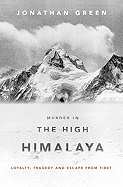

Thornton Wilder employed a highly effective narrative device in his Pulitzer Prize-winning novel The Bridge of San Luis Rey (1927): a disaster in a remote area results in the death of many; the novel's narrator investigates the lives of all present at the disaster and the events that led to their being at the site when disaster struck. Jonathan Green works a modern variation on this time-tested structure to recount this tale of tragedy in Tibet.
On September 30, 2006, near Cho Oyu mountain in the high Himalaya, Chinese border guards opened fire on a group of Tibetans attempting to flee to Nepal via the Nanga La, a mountain path popular as an escape route. Many of those in the group died. In Wilder's novel, the collapse of the bridge at San Luis Rey killed everyone involved. Green has the benefit of a large number of surviving witnesses, including Tibetan refugees, sherpas, Western mountaineers and a Romanian documentary maker who captured the horrifying incident on film.
Green provides extensive background on the diverse elements that contributed to and converged in the final confrontation at Nanga La: life in the Tibetan village of Juchen where the teenage girls Dolma Palkyi and Dolkar Tsomo grew up; the business of mountaineering in Tibet; Chinese policies to obliterate Tibetan tradition, religion, language and nomadic culture after the invasion of October 1950; and the code of silence enforced by the Chinese government regarding its human-rights violations in Tibet. With so many different stories to tell, Green adopts the kaleidoscopic approach currently popular for television series and action movies. Within two pages he can skip from, "According to Tibetan tradition at least one child in each family should join the monastic life to ensure an accrual of merit for the family" to "in August 2007, a [Chinese Communist Party] decree was passed that prohibited tulkus (reincarnated lamas) from reincarnating without prior permission from the Communist Party." At times, the effect of absorbing so much information on so many topics can be as dizzying and exhilarating as a high-altitude climb.
At the center of Green's gripping story stand Dolma Palkyi and Dolkar Tsomo and their determination to journey to Dharamsala to meet the exiled Dalai Lama. Off to one side are the mountaineers who witness atrocities but remain stonily silent (Green asserts that many don't want to endanger future access to the mountains by alienating Chinese authorities). In the end, distressing moral dilemmas of our time emerge from this tale of religious pilgrims gunned down on an icy mountain path within view of self-absorbed climbers thinking only of their next summit.--John McFarland
Shelf Talker: A shattering tale that will appeal to readers of all things about Tibet, mountaineering, human rights and the preservation of cultural integrity.

